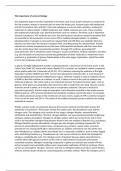The importance of cycles in biology
One important stage in aerobic respiration is the Krebs cycle. From acetyl-coenzyme A, produced in
the link reaction, acetate is removed and can enter the Krebs cycle. Acetate reacts with oxaloacetic
acid (4C) to produce citric acid (6C). Citric acid undergoes a series of redox reactions, producing 2
molecules of carbon dioxide, 3 NADH molecules and 1 FADH molecule per cycle. These reactions
2
also regenerate oxaloacetic acid, allowing the Krebs cycle to continue. The Krebs cycle is important
because it produces 1 ATP molecule per cycle, but also because it produces reduced coenzymes that
are essential for the production of even more ATP in oxidative phosphorylation. In oxidative
phosphorylation, hydrogen is removed from reduced NAD and FAD (they are oxidised). Electrons
released can then enter the electron transport chain, providing energy for chemiosmosis. Protons
released are actively transported across the inner mitochondrial membrane and then move back
into the matrix down their concentration gradient, through ATP synthase, generating ATP
(chemiosmosis). ATP is needed for active transport, muscle contraction, anabolic reactions, secretion
(e.g. the formation of lysosomes) and the phosphorylation of other molecules to make them more
reactive (e.g. production of glucose bisphosphate in the early stages of glycolysis, which then splits
to form two molecules of pyruvate).
In plants, the light-independent reaction of photosynthesis is also known as the Calvin Cycle. In the
Calvin Cycle, RuBP (5C) reacts with carbon dioxide (1C) to produce an unstable 6-carbon compound,
which quickly splits into 2 molecules of GP (3C). GP is reduced, requiring the products of the light-
dependent reaction (NADPH and ATP), to two triose phosphate molecules (3C). A small amount of
triose phosphate goes towards making hexose sugars, while the majority is used to replenish stores
of RuBP so that the reaction can continue. As such, it takes six turns of the cycle to produce one
molecule of glucose. The Calvin Cycle is very important because it produces hexose sugars, such as
glucose. Since plants are autotrophs, they need to be able to make their own food. Glucose may be
stored as starch in plants, or it may be used as a respiratory substrate. Glucose is reduced to
pyruvate in glycolysis, the first stage of respiration, and is therefore essential to the whole process.
Without glucose, ATP cannot be produced and metabolic reactions cannot take place. For example,
the sodium potassium pumps in the membranes of axons need a supply of ATP to actively transport
3 Na+ out of the axon and 2K+ in. The action of the sodium potassium pumps maintains the resting
potential of neurons.
Thirdly, nutrient cycles are important because they recycle nutrients and therefore ensure the
perpetuity of ecosystems. Three types include the carbon cycle, the phosphorus cycle and the
nitrogen cycle. The nitrogen cycle consists of four stages: nitrogen fixation, ammonification,
nitrification and denitrification. The first, nitrogen fixation, can occur electrochemically by lightning
(nitrogen oxidises atmospheric nitrogen to nitrogen oxides, which are carried to the soil as nitric
acid) or by mutualistic nitrogen-fixing bacteria found in the root nodules of legumes (e.g. pea plants).
Nitrogen fixation converts atmospheric nitrogen gas into nitrogen-containing compounds. The
process of ammonification converts these compounds (e.g. proteins, nucleic acids, urea) into
ammonium ions. During nitrification, Nitrosomonas sp. oxidises ammonium ions into nitrite ions,
then Nitrobacter sp. oxidises nitrites into nitrate ions. In anaerobic conditions, such as water-logged
soils, denitrifying bacteria (e.g. Pseudomonas sp.) can convert nitrate ions back into atmospheric
nitrogen, completing the cycle. The nitrogen cycle is important because plants need nitrates to
combine them with glucose and form amino acids to make proteins for growth and enzyme-
controlled reactions. Nitrogen-containing compounds in plants and animals also include ATP (for
active transport) and nucleotides (allows semi-conservative replication of DNA to continue). Plants
cannot use atmospheric nitrogen, however, and rely on nitrogen fixation to produce useful nitrates,
whereas animals obtain nitrates by consuming plants and other animals. When the nitrogen cycle is




